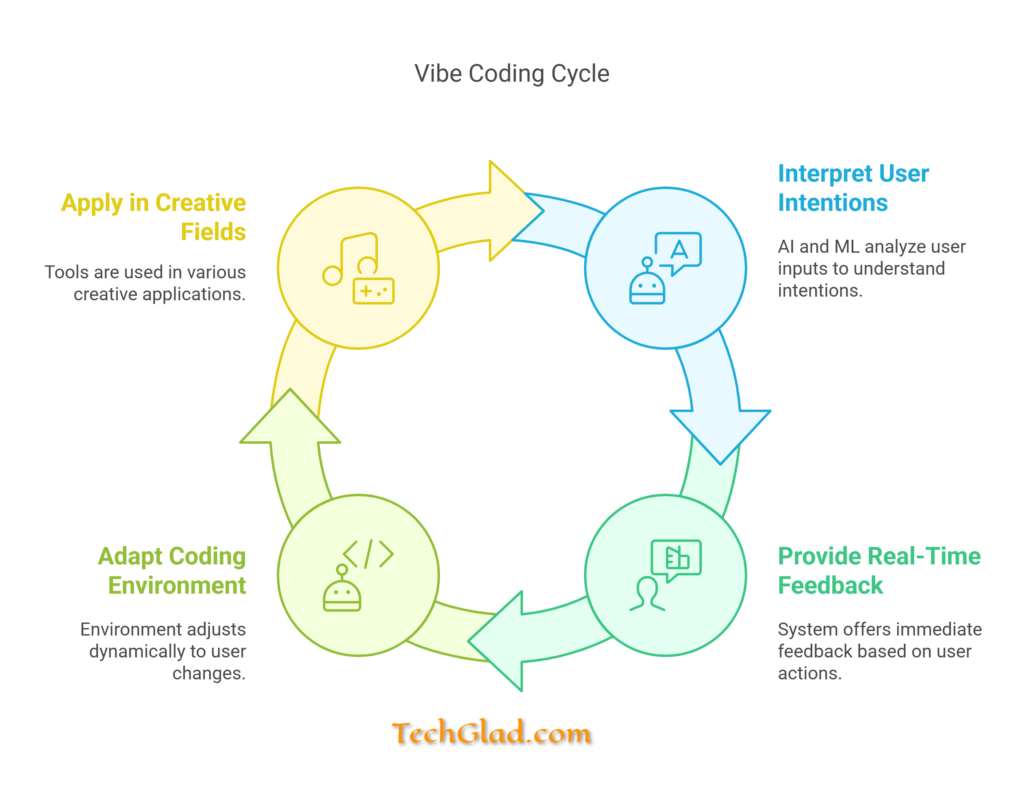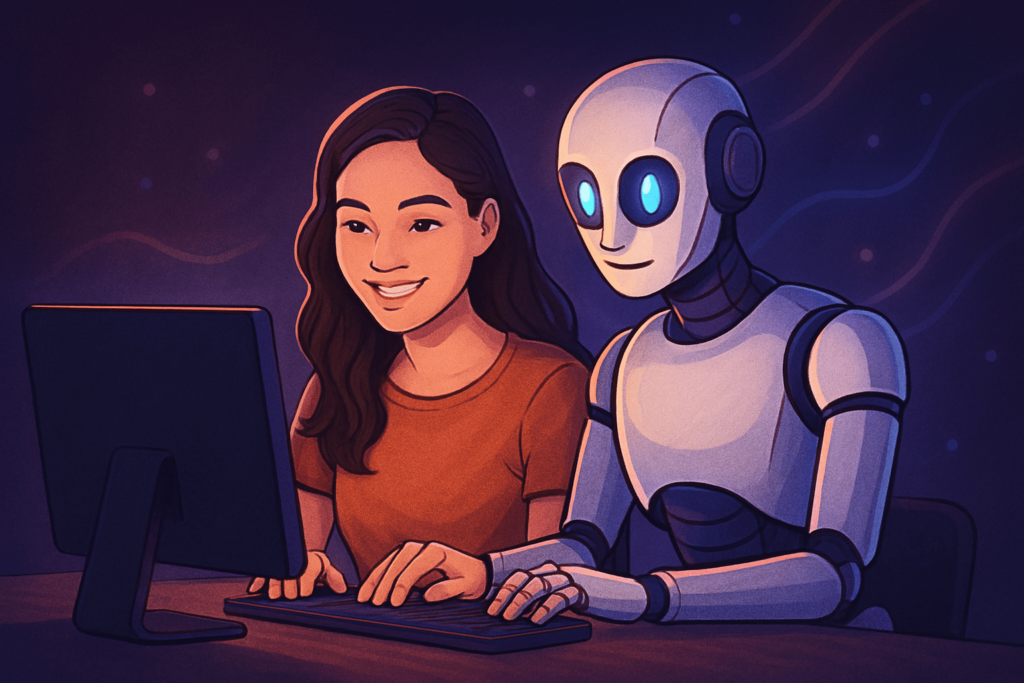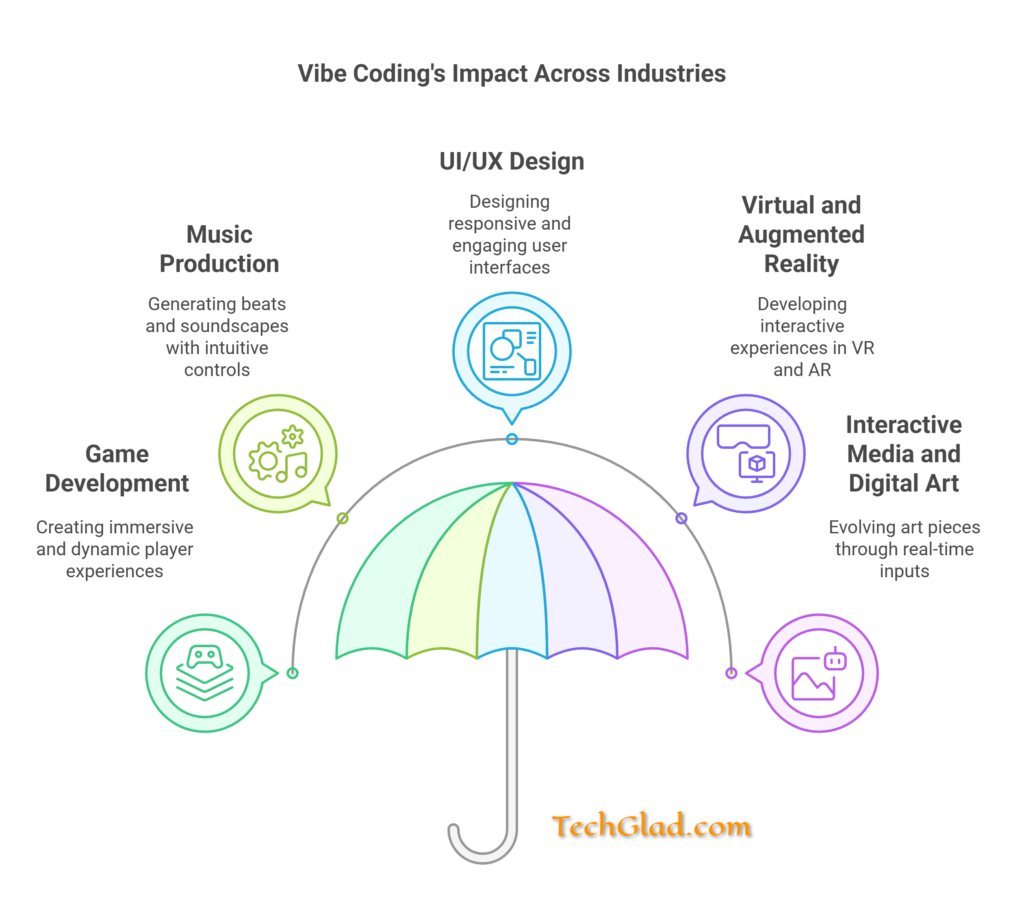Vibe coding is a new and intuitive approach to programming that prioritizes creativity, adaptability, and real-time user interaction. Unlike traditional coding, which follows strict syntax and predefined structures, vibe coding is “more fluid” and focuses on the “feel” of a program rather than just its functionality.
I will explain you more about this trending word “Vibe Coding” on social media which has caused lot of discussions among the developers community as well. Will vibe coding replaces the programmers? Can business owners or analysts just give some instructions and get a code created without the help of junior developers? May be you should read is prompt over hyped? first to understand this vibe coding concept better.
Vibe Coding Explained in a Simple Way
At its core, vibe coding involves using artificial intelligence (AI), machine learning (ML), and advanced algorithms to interpret user intentions and preferences dynamically. It often incorporates visual programming, real-time feedback, and adaptive coding environments that allow developers to make changes on the fly without breaking the entire system. This makes vibe coding particularly useful for creative applications such as game development, music production, UI/UX design, and interactive media.
Here are some of the top AI terms you should know to keep yourself ahead in this AI generation.
Vibe Coding Cycle Graphical Representation (Infographics)
Here is the graphical representation (infographics) of various stages involved in the vibe coding process. I will explain you more about these stages and how to implement them in my next articles.

Do You Know?
Do you know that the word “vibe coding” was introduced very recently in February 2025 by a computer scientist Andrej Karpathy. It all started just as a tweet. Here is the link of his actual tweet.
Andrej Karpathy, a former director of AI at Tesla and a founding member of OpenAI says that development of an application can be done by just whispering what we want and almost forget that code even exists. The rapid advancements of AI code editors make this possible. You don’t need to know the syntax, no need to read documentation and no need to manually adjust the parameters to get the desired results.
It all started with a concept tweet in 2023 as “The hottest new programming language is English”.
How Vibe Coding Differs from Traditional Coding Methods
Traditional coding methods rely on structured logic, strict syntax, and linear execution. They require developers to write explicit instructions for every functionality within a program. In contrast, vibe coding introduces a more flexible, human-centric approach by incorporating AI-driven tools that adapt to user inputs in real time.
Here are some key differences:
- Syntax vs. Intuition – Traditional coding requires knowledge of programming languages like Python, Java, or C++, whereas vibe coding often minimizes the need for syntax-heavy coding by using AI-assisted tools and visual programming.
- Static vs. Dynamic – Traditional programming follows a set structure where changes require recompilation, while vibe coding allows for fluid modifications without major disruptions.
- Rule-Based vs. Adaptive – Traditional coding enforces predefined rules, whereas vibe coding adapts to user inputs and intentions dynamically.
- Complexity vs. Simplicity – Traditional coding can be complex and rigid, while vibe coding prioritizes ease of use and accessibility.
Main Benefits of Using Vibe Coding

Vibe coding offers several advantages over conventional programming methods, making it a preferred choice for many developers, artists, and creators. Some of the key benefits include:
1. Enhanced Creativity
Vibe coding allows developers to focus more on the artistic and experiential aspects of their projects rather than getting bogged down by technical constraints. This is particularly beneficial in creative fields like game design, animation, and multimedia content creation.
2. Faster Prototyping
Since vibe coding relies on intuitive tools and real-time feedback, developers can create prototypes more quickly. This rapid development cycle helps in testing ideas efficiently and making improvements on the go.
3. Lower Barrier to Entry
With AI-assisted programming and visual interfaces, vibe coding makes software development accessible to non-programmers, enabling artists, designers, and musicians to create digital content without extensive coding knowledge.
4. Dynamic Adaptability
Vibe coding tools can learn and adapt based on user behavior and project needs, making them more flexible than traditional static coding methods.
5. Improved User Experience
Since vibe coding emphasizes interaction and real-time feedback, it results in more immersive and engaging user experiences, especially in applications like gaming, virtual reality (VR), and augmented reality (AR).
Also Read: Large vs Small Language Models: Key Differences and Use Cases Explained
Real-World Applications of Vibe Coding

Vibe coding is revolutionizing various industries by offering innovative solutions for interactive and adaptive experiences. Here are some of the most prominent applications:
1. Game Development
Game designers use vibe coding to create immersive environments, real-time physics interactions, and adaptive AI behaviors without manually scripting every detail. This allows for more dynamic and player-driven experiences.
2. Music Production
Musicians and producers utilize vibe coding to generate beats, effects, and soundscapes based on intuitive controls rather than traditional MIDI sequencing and manual input.
3. UI/UX Design
Vibe coding is instrumental in designing user interfaces that respond dynamically to user interactions, making applications and websites more intuitive and engaging.
4. Virtual and Augmented Reality
Vibe coding is heavily used in VR and AR applications to create responsive and interactive experiences where objects and environments react dynamically to user inputs.
5. Interactive Media and Digital Art
Artists use vibe coding tools to create interactive installations, digital paintings, and generative art pieces that evolve based on real-time inputs.
Best Tools for Vibe Coding
Several tools and platforms support vibe coding, providing an intuitive and interactive programming experience. Here are some of the best tools available:
1. TouchDesigner
A powerful tool for creating real-time visual effects and interactive experiences, widely used in digital art and live performances.
2. Max/MSP
A visual programming language for music and multimedia, allowing artists and musicians to experiment with sound and visuals without deep coding expertise.
3. Unreal Engine’s Blueprints
Unreal Engine’s Blueprints system enables developers to create game logic using a node-based visual scripting interface rather than traditional coding.
4. Unity Visual Scripting
Formerly known as Bolt, Unity Visual Scripting lets game developers create complex interactions without writing code.
5. Processing
A flexible coding platform designed for visual artists and designers, allowing for creative coding with an easy-to-learn syntax.
Limitations of Vibe Coding
While vibe coding offers numerous benefits, it is not without its drawbacks. Here are some limitations to consider:
1. Limited Control
Because vibe coding relies on AI-driven and visual programming tools, developers may have less control over lower-level system functions compared to traditional coding.
2. Performance Constraints
Vibe coding tools may not be as optimized for high-performance applications that require fine-tuned efficiency, such as real-time systems and enterprise software.
3. Learning Curve for Advanced Users
While vibe coding makes it easier for beginners, experienced developers may find it challenging to transition from traditional coding due to the abstraction of certain programming elements.
4. Dependence on Proprietary Tools
Many vibe coding platforms are proprietary, meaning developers are often limited by the features and capabilities provided by a specific tool or company.
5. Not Suitable for All Projects
Certain types of software, such as financial systems, security-focused applications, and backend server logic, may still require traditional coding approaches due to strict performance and security requirements.
History and Evolution of Vibe Coding
Vibe coding emerged as a response to the growing need for more intuitive and adaptive programming methods. Early programming relied on strict syntax and predefined logic, but advancements in AI, machine learning, and visual programming paved the way for a more interactive approach. Early tools like Scratch and Max/MSP introduced visual coding, making programming more accessible and creativity-driven.
With the rise of AI-powered development environments, vibe coding became more refined, allowing developers to create applications using natural language, gesture-based inputs, and real-time feedback. Modern tools like Unreal Engine’s Blueprints and Unity’s Visual Scripting further expanded this approach, enabling dynamic, experience-driven software development. As technology continues to evolve, vibe coding is expected to become even more seamless and widely adopted.
Core Principles of Vibe Coding
Vibe coding is built on interactivity, adaptability, and user-centric design. Unlike traditional programming, which focuses on logic and structure, vibe coding prioritizes real-time feedback and fluid adjustments. Developers can modify programs dynamically, making it ideal for creative fields like game development, music production, and digital art.
Another key principle is AI assistance, which helps interpret user intent and streamline the coding process. Instead of manually writing complex logic, developers can use AI-powered tools to generate and refine code. By focusing on creativity and user experience, vibe coding simplifies development while allowing for greater experimentation and customization.
How Vibe Coding Enhances Productivity
Vibe coding significantly speeds up the development process by reducing the need for rigid coding structures. Real-time feedback allows developers to instantly see changes, eliminating the long debugging cycles associated with traditional programming. This makes prototyping faster and more efficient, helping creators quickly refine their ideas.
Additionally, vibe coding fosters collaboration between designers, developers, and content creators by using intuitive interfaces like visual scripting and AI-generated suggestions. This lowers the learning curve and enables teams to work together seamlessly, resulting in a smoother and more productive development workflow.
Frequently Asked Questions of Vibe Coding
1. Do I need programming experience to use vibe coding?
Not necessarily. Many vibe coding tools are designed to be user-friendly and accessible to non-programmers. However, understanding basic programming concepts can be helpful.
2. Is vibe coding replacing traditional programming?
No, vibe coding complements traditional programming rather than replacing it. It is particularly useful for creative and interactive applications but may not be suitable for all types of software development.
3. Can I use vibe coding for professional software development?
Yes, but it depends on the type of software. Vibe coding is excellent for game development, digital art, and multimedia applications but may not be the best choice for large-scale enterprise solutions.
4. What industries benefit the most from vibe coding?
Industries such as gaming, music production, digital art, UI/UX design, VR/AR, and interactive media benefit the most from vibe coding.
5. Are there any free vibe coding tools available?
Yes, some tools like Processing and certain versions of Unreal Engine’s Blueprints are free to use. However, more advanced features in some platforms may require a paid license.
6. How do I get started with vibe coding?
Start by exploring beginner-friendly tools like Processing, TouchDesigner, or Unreal Engine’s Blueprints. Experiment with tutorials and small projects to familiarize yourself with the concept.
Conclusion
Vibe coding is revolutionizing the way we approach programming by making it more intuitive, adaptive, and accessible. By prioritizing real-time feedback and interactive elements, it transforms creative industries and enables a new generation of developers, artists, and designers. While it has its limitations, the benefits of vibe coding make it an exciting and valuable addition to the world of software development.


